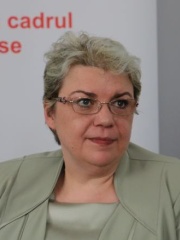

The Most Famous
ECONOMISTS from Romania
This page contains a list of the greatest Romanian Economists. The pantheon dataset contains 414 Economists, 2 of which were born in Romania. This makes Romania the birth place of the 28th most number of Economists behind Zambia, and Switzerland.
Top 2
The following people are considered by Pantheon to be the most legendary Romanian Economists of all time. This list of famous Romanian Economists is sorted by HPI (Historical Popularity Index), a metric that aggregates information on a biography's online popularity.

1. Nicholas Georgescu-Roegen (1906 - 1994)
With an HPI of 62.54, Nicholas Georgescu-Roegen is the most famous Romanian Economist. His biography has been translated into 22 different languages on wikipedia.
Nicholas Georgescu-Roegen (born Nicolae Georgescu, 4 February 1906 – 30 October 1994) was a Romanian mathematician, statistician and economist. He is best known today for his 1971 magnum opus The Entropy Law and the Economic Process, in which he argued that all natural resources are irreversibly degraded when put to use in economic activity. A progenitor and a paradigm founder in economics, Georgescu-Roegen's work was decisive for the establishing of ecological economics as an independent academic sub-discipline in economics. In the history of economic thought, Georgescu-Roegen was the first economist of some standing to theorise on the premise that all of earth's mineral resources will eventually be exhausted at some indeterminate future point. In his paradigmatic magnum opus, Georgescu-Roegen argues that economic scarcity is rooted in physical reality; that all natural resources are irreversibly degraded when put to use in economic activity; that the carrying capacity of earth – that is, earth's capacity to sustain human populations and consumption levels – is bound to decrease sometime in the future as earth's finite stock of mineral resources is being extracted and put to use; and consequently, that the world economy as a whole is heading towards an inevitable future collapse, ultimately bringing about human extinction. Due to the radical pessimism inherent to his work, based on the physical concept of entropy, the theoretical position of Georgescu-Roegen and his followers was later termed 'entropy pessimism'. Georgescu-Roegen graduated from Sorbonne University in 1930 with a PhD in mathematical statistics with the highest honors. Early in his life, Georgescu-Roegen was the student and protégé of Joseph Schumpeter, who taught that irreversible evolutionary change and 'creative destruction' are inherent to capitalism. Later in life, Georgescu-Roegen was the teacher and mentor of Herman Daly, who then went on to develop the concept of a steady-state economy to impose permanent government restrictions on the flow of natural resources through the (world) economy. As he brought natural resource flows into economic modelling and analysis, Georgescu-Roegen's work was decisive for the establishing of ecological economics as an independent academic sub-discipline in economics in the 1980s. In addition, the degrowth movement that formed in France and Italy in the early-2000s recognises Georgescu-Roegen as the main intellectual figure influencing the movement. Taken together, by the 2010s Georgescu-Roegen had educated, influenced and inspired at least three generations of people, including his contemporary peers, younger ecological economists, still younger degrowth organisers and activists, and others throughout the world. Several economists have hailed Georgescu-Roegen as a man who lived well ahead of his time, and some historians of economic thought have proclaimed the ingenuity of his work. In spite of such appreciation, Georgescu-Roegen was never awarded the Nobel Prize in Economics, although benefactors from his native Romania were lobbying for it on his behalf. After Georgescu-Roegen's death, his work was praised by a surviving friend of the highest rank: Prominent Keynesian economist and Nobel Prize laureate Paul Samuelson professed that he would be delighted if the fame Georgescu-Roegen did not fully realise in his own lifetime were granted by posterity instead. The inability or reluctance of most mainstream economists to recognise Georgescu-Roegen's work has been ascribed to the fact that much of his work reads like applied physics rather than economics, as this latter subject is generally taught and understood today. Georgescu-Roegen's work was blemished somewhat by mistakes caused by his insufficient understanding of the physical science of thermodynamics. These mistakes have since generated some controversy, involving both physicists and ecological economists.

2. Sevil Shhaideh (b. 1964)
With an HPI of 51.24, Sevil Shhaideh is the 2nd most famous Romanian Economist. Her biography has been translated into 31 different languages.
Sevil Shhaideh (Romanian pronunciation: [ˈsevil ˈʃajde]; Dobrujan Tatar: Sevil Şayideh, née Geambec (Dobrujan Tatar: Ğambek, Crimean Tatar: Cambek); born 4 December 1964) is a Romanian economist, civil servant and politician. On 21 December 2016, she was proposed by the Social Democrats to be Prime minister of Romania, but was rejected by the president, Klaus Iohannis.
People
Pantheon has 2 people classified as Romanian economists born between 1906 and 1964. Of these 2, 1 (50.00%) of them are still alive today. The most famous living Romanian economists include Sevil Shhaideh. The most famous deceased Romanian economists include Nicholas Georgescu-Roegen.

